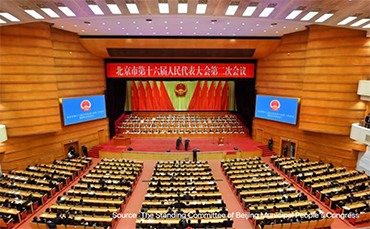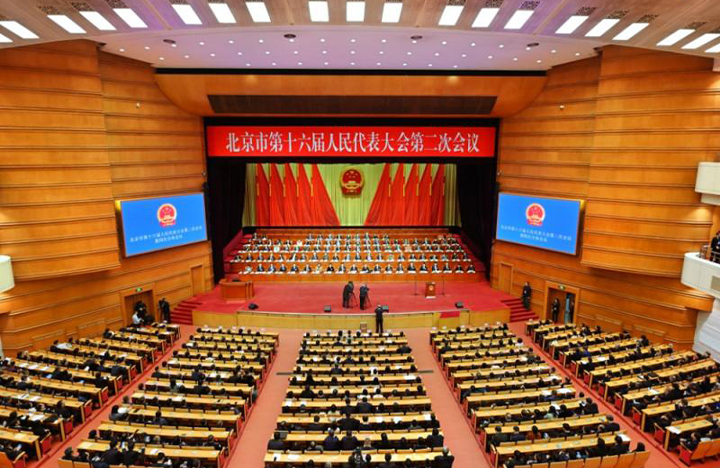



[Photo/The Standing Committee of Beijing Municipal People's Congress]
On January 21st , Yin Yong, the mayor of Beijing expressed his vision of Beijing-Tianjin-Hebei metropolitan area during the second session of the 16th People's Congress of Beijing Municipal People's Congress when delivering the government work report.
“Year 2024 launches the 10th anniversary of the implementation of the Beijing-Tianjin-Hebei coordinated development strategy. Beijing will tackle the key of relocating non-capital functions to adjacent regions, thus accelerate the construction of a modern capital metropolitan area. Together with Tianjin and Hebei, it aims to jointly create a pioneering and demonstrative site for China’s urbanisation process.”
As noted by Yin Yong, in 2023, Beijing solidly reassured its geographic strategic position as the capital city, elevated the coordinated development of the Beijing-Tianjin-Hebei region. This year, Beijing will continue to enhance its function as the capital, promoting new and greater progress in the coordinated regional development.
Yin Yong emphasized the need to effectively implement a comprehensive strategy for relocation, rectification, and promotion ("zu he quan" - a combination of measures). Actively serving to ensure the outward relocation of emblematic projects of central units, completing the second phase of municipal government office relocation. Improving the policy framework for incentives and constraints in relocation, achieving a further reduction of 6.5 square kilometers in urban and rural construction land, ensuring a real-time clearance of new illegal construction. Optimizing the layout of education and medical resources, expediting the construction of projects such as Capital Medical University and the Tongzhou campus of the Capital Institute of Pediatrics. Steadily advancing specific tasks such as environmental improvement along the railway, the rectification of urban-rural junction areas, and initiatives like greening bridges and increasing open green spaces. Meticulously governing 1650 small alleys, advancing the functional reshaping and quality improvement of areas such as Dahongmen.
Yin Yong stated that the construction of Tianjin and Hebei as " the Two Supportive Wing of Beijing" is anticipated to speed up.The implementation of the new strategic cooperation agreement between Beijing and Xiong'an New Area in Hebei Province will be prioritized, promoting the cross city border sharing of administrative services, deepening collaboration in education and medical services under the "Three Schools and One Hospital"(kindergarten, primary school and secondary school supported by Beijing schools with rich educational experiences; one general hospital) initiative, and jointly establishing the Zhongguancun Science and Technology Park in Xiong'an New Area, Hebei.
The high-quality development of Beijing's urban sub-center will be expedited, maintaining a substantial investment scale, initiating the construction of the East Sixth Ring Express Park, achieving basic completion of the primary projects of the integrated transportation hub in the urban sub-center, and making the East Sixth Ring underground transformation project ready for operation. Large scale projects such as the construction of Metro Line 101 and Line 22 will be implemented, ensuring the completion and operation of the Changtong Road construction project. Plans for advancing the Universal Theme Park Phase II, accelerating the construction of Chaobai River National Forest Park, and promoting breakthroughs in the development of the "Two Demonstration Zones" are also in progress.
Yin Yong expressed the intention to deepen collaborative innovation and industrial cooperation. There will be active promotion of the construction of the Beijing-Tianjin-Hebei National Technology Innovation Center, guiding and supporting collaborative efforts among innovation entities in the three regions for the incubation and pilot testing of outcomes. The industrial layout of the "Six Chains and Five Groups" will be expedited, implementing specific strategies for each link to extend industrial chains and facilitate collaborative support. Special emphasis will be placed on creating demonstration zones for coordinated development in the Beijing-Tianjin-Hebei region, including the Jing-Ji Cao Fei Dian and the Beijing-Zhangjiakou Sports, Culture, and Tourism Belt, to promote the development of a demonstration city cluster for fuel cell vehicles. The coordination between Beijing and Tianjin, especially in innovative industrial areas like the Tianjin Binhai-Zhongguancun Science and Technology Park, will be emphasized.
He pointed out that, in strengthening the joint construction and sharing of public services, efforts will be made to consolidate and enhance the "Beijing-Tianjin-Hebei on Rails," completing the first phase of the intercity railway connection line and opening the high-speed section of the new National Road 109. Measures will be taken to strengthen emergency responses to heavy air pollution weather and implement ecological protection and restoration projects such as the Northern Anti-sand Belt.
Source: <https://www.planning.org.cn/news/view?id=15089>;
<http://www.bjrd.gov.cn/xwzx/lbt/202401/t20240124_3543829.html>
Translated by Xiong Yuxi